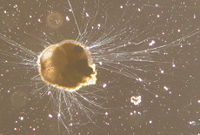Rhizaria
The Rhizaria are a species-rich supergroup of protists. They vary considerably in form, but for the most part they are amoeboids with filose, reticulose, or microtubule-supported pseudopods. Many produce shells or skeletons, which may be quite complex in structure, and these make up the vast majority of protozoan fossils. Nearly all have mitochondria with tubular cristae.Groups
There are three main groups of Rhizaria:
⇒ Cercozoa - Various amoebae and flagellates, usually with filose pseudopods and common in soil
⇒ Foraminifera - Amoeboids with reticulose pseudopods, common as marine benthos
⇒ Radiolaria - Amoeboids with axopods, common as marine plankton
Rhizaria Fossil range: Neoproterozoic - Recent |
|
 |
|
| Live Ammonia tepida (Foraminifera) | |
A few other groups may be included in the Cercozoa, but on some trees appear closer to the Foraminifera. These are the Phytomyxea and Ascetosporea, parasites of plants and animals respectively, and the peculiar amoeba Gromia. The different groups of Rhizaria are considered close relatives based mainly on genetic similarities, and have been regarded as an extension of the Cercozoa. The name Rhizaria for the expanded group was introduced by Cavalier-Smith in 2002, who also included the centrohelids and Apusozoa.
Evolutionary relationship
Rhizaria is part of the bikont clade, which also comprises the Archaeplastida, the Chromalveolata, the Excavata, and some smaller, unresolved groups such as the Apusozoa and the Centrohelida. As bikonts, they all descend from a heterotrophic eukaryote with two flagella. Historically, many rhizarians were considered animals, with their motility and heterotrophy as justification. However, when the five-kingdom system took prevalence over the animal-plant dichotomy, the rhizarians were put into the kingdom Protista. Then, after Woese published his three-domain system, because of the paraphyly of the kingdom Monera, taxonomists turned their attention to the eukaryote domain, and the inherent paraphyly of Protista. After much debate, which continues to this day, Rhizaria emerged as a monophyletic group.
References
| - | Cavalier-Smith, Thomas (2002). "The phagotrophic origin of eukaryotes and phylogenetic classification of Protozoa". International Journal of Systematic and Evolutionary Microbiology 52 (2): 297–354. |
| - | Fabien, Burki; Kamran Shalchian-Tabrizi, Marianne Minge, Åsmund Skjæveland, Sergey I. Nikolaev, Kjetill S. Jakobsen, Jan Pawlowski (2007). "Phylogenomics Reshuffles the Eukaryotic Supergroups". PLoS ONE 2 (8): e790-. |
| - | Moreira D, von der Heyden S, Bass D, López-García P, Chao E, Cavalier-Smith T (July 2007). "Global eukaryote phylogeny: Combined small- and large-subunit ribosomal DNA trees support monophyly of Rhizaria, Retaria and Excavata". Mol. Phylogenet. Evol. 44 (1): 255–66. |
| - | Nikolaev SI, Berney C, Fahrni JF, et al (May 2004). "The twilight of Heliozoa and rise of Rhizaria, an emerging supergroup of amoeboid eukaryotes". Proc. Natl. Acad. Sci. U.S.A. 101 (21): 8066–71. |




